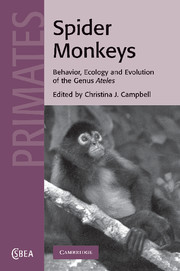1 - Introduction
Published online by Cambridge University Press: 05 May 2010
Summary
For those outside of the primatological community, it may seem surprising that this is the first volume about spider monkeys (genus Ateles). However, while they are often seen as the “typical monkey,” mischievously hanging from their tails, swinging through the trees and eating fruit, spider monkeys are relatively unstudied in the wild compared with many species of Old World monkey, and other New World genera such as capuchin monkeys (Cebus spp.) and howler monkeys (Alouatta spp.). Indeed there are more data concerning most aspects of the social lives of the highly endangered muriqui (Brachyteles spp.), thanks largely to the long-term studies of Karen Strier, than the more common and much more widely distributed spider monkey.
Spider monkeys are fast moving, wide ranging and high canopy animals whose social system often means that only a few community members can be followed at any one time. Such features make the study of wild spider monkeys notoriously difficult, and are almost certainly the reasons behind the historical dearth of long-term studies of the genus. That said, the number of field studies of spider monkeys has exploded over the last decade (Table 1.1). Studies have been, or are being, carried out by researchers at all levels in academia, and perhaps most importantly there has been an increase in the number of students carrying out their Ph.D. research at various sites throughout the spider monkey range.
- Type
- Chapter
- Information
- Spider MonkeysThe Biology, Behavior and Ecology of the Genus Ateles, pp. 1 - 16Publisher: Cambridge University PressPrint publication year: 2008
References
- 1
- Cited by

